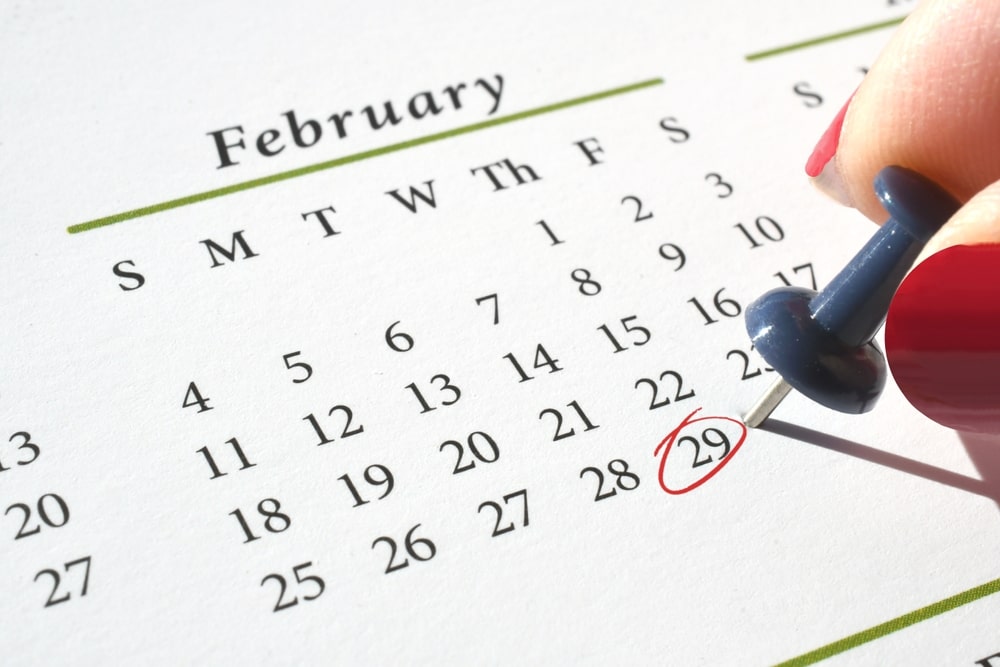Let’s unlock the mystery of leap years!
We know that February 29th comes every four years and is a special yet ordinary day for many of us, except those who celebrate their birthdays, of course, but why do we have leap years? Do they have a purpose? How did they come about?
But before we dive deep into the subject, we need to tackle a few basic details. Leap years have 366 days on the calendar instead of the standard 365. According to the Gregorian calendar, which is the one most people use worldwide, we have an extra day every fourth year, which is called leap day.
Scientists discovered that all years divisible by four, like 2020 and 2024, are leap years, except a few centenary years or years ending in 00, like 1900. Now that we know a bit more about these special years, it’s time to talk about why they exist, what purpose they serve (if there’s any), and why we need them. Let’s begin!

Where does the name come from?
You’re probably curious about the name “Leap,” and its story is pretty interesting. It comes from the fact that, starting in March, every date in a leap year is one day ahead of the previous year. For instance, March 1st, 2027, will fall on a Monday, but the next leap year, which is 2028, will be on a Wednesday. Usually, the same date only advances by just one day between consecutive years, but leaps are special.
What about other calendars?
Even though the majority of the world uses the Gregorian calendar, there are many others available, and each one of them is special and has its own version of leap years.
For instance, the Islamic calendar, the Ethiopian calendar, the Hebrew calendar, and the Chinese calendar all have other versions of these special years. What’s interesting is that they don’t all come every four years and often happen in different years than those in the Gregorian calendar.
Moreover, scientists say that particular calendars have multiple lead days or even shortened leap months, so we can say that the world has different versions of how many days a year it gives us.
Besides leap days and years, the Gregorian calendar contains leap seconds. The most recent additions of leap seconds to specific years were in 2012, 2015, and 2016. However, some things will change sooner or later because, starting in 2035, leap seconds will no longer be used by the International Bureau of Weights and Measures (IBWM), which is in charge of maintaining timekeeping throughout the world.
Why are they important?
While for some people it might seem like a silly idea, scientists discovered that leap years are important, and without them, things wouldn’t be the same. The reason they exist is that a Gregorian year is somewhat shorter than a solar, or tropical, year, which is the time necessary for our planet to fully orbit the sun.
A calendar year’s length is 365 days, but a solar year is approximately 365. 24 days long, or 365 days, 5 hours, 48 minutes, and 56 seconds.
If we didn’t consider this discrepancy, the time difference between the beginning of a solar year and a calendar year would increase by 5 hours, 48 minutes, and 56 seconds for every year that went by. Over time, this would affect the seasons’ timing.
Let’s say that we stopped using leap years from now on. While we might not see any difference, in around 700 years, the Northern Hemisphere’s summer would begin in December instead of June, as experts from the National Air and Space Museum say.
Adding a simple leap day every fourth year is a huge problem solver because an extra day is roughly the same length as the difference that accumulates during this time. Considering that many things are imperfect, this system is not that great either. We have an additional 44 minutes every four years, or a day every 129 years.
To solve this issue, we say no-no to leap years every centenary year, except for those that are divisible by 400, like 1600 and 2000. But even though people find different ways to deal with this, there’s still a small difference between solar years and calendar years, which is why IBWM thought about experimenting with leap seconds.
Long story short, we can say that leap years mean that the Gregorian calendar we use is coordinated with Earth’s journey around the sun.

Why is Leap Day on February 29th?
We’ve talked about the scientific reasons why we have leap years, but we didn’t say anything about why the special day is on February 29th. In the eighth century B.C., the Roman calendar had ten months, starting in March and ending in December. There were no months to symbolize the chilly winter season, so people didn’t think about it.
January and February were later added to the end of the ecclesiastical year, but this calendar only had 304 days, and February was the final month with the fewest days. However, the Romans quickly connected these months to the beginning of the civil year, and by approximately 450 B.C., January was considered the first month of the year.
February was the shortest month; therefore, during leap years, it was one day longer before Pope Gregory XIII added the leap day to the Gregorian calendar in 1582. Maybe that’s why we tend to feel more alive and happy when the spring season is here. Some people say that spring is our biological beginning of the year, and considering this story regarding how January and February were added at the beginning of the calendar, we can see why.
Leap years and their history
The idea of leap years isn’t new, and it dates back to 45 B.C. when Ancient Roman ruler Julius Caesar created the Julian calendar, which consisted of 365 days divided into the 12 months that are now used in the Gregorian calendar. This was the period when leap years became a thing, and the concept stuck with us.
The “final year of confusion” was in 46 B.C. and consisted of 15 months totaling 445 days. A lot, I know! According to the University of Houston, this allowed the Julian calendar to incorporate leap years every four years without fail and to be in line with Earth’s seasons.
The Julian calendar worked amazingly for centuries, but by the middle of the 16th century, astronomers said there was a problem. Seasons were beginning roughly 10 days earlier than expected, and important holidays, such as Easter, no longer matched with specific events, like spring, the equinox, or the vernal.
To solve this issue, in 1582, Pope Gregory XIII came up with the Gregorian calendar idea, which is almost identical to the Julian calendar but with the exclusion of leap years for the majority of centenary years.
The Gregorian calendar was used by Catholic countries, such as Spain and Italy, for many years, but after a while, Protestant countries adopted it too. For instance, Great Britain adopted this calendar in 1752.
Due to the difference between calendars, countries that switched to the Gregorian calendar had to remove a few days to be in sync with the rest of the world. For example, according to the Royal Museums Greenwich, when Great Britain made the big decision, September 2nd was followed by September 14th.
Scientists say that at some point in the future, the Gregorian calendar might need to be reassessed since it’s starting to drift apart from solar years. However, thousands of years will pass until this happens. Since we’ve talked about leap years and calendars so much, here’s something fun and interesting for you!
What do you think about this article? Did you find the topic interesting? Let us know in the comments below! If you enjoyed reading this post and want to check out something else from Science in The World, here’s a good article for you: Eye Drop Recall: 27 Meds Thousands Took, Pulled From the Market













